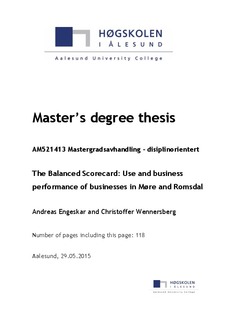The balanced scorecard : use and business performance of businesses in Møre and Romsdal
Master thesis
Permanent lenke
http://hdl.handle.net/11250/301173Utgivelsesdato
2015Metadata
Vis full innførselSamlinger
Sammendrag
Although ‘The Balanced Scorecard’ (BSC) has been a popular tool amongst companies for some decades, its use and benefits have been little researched in Norway. This thesis focuses on companies in Møre and Romsdal. It investigates the extent of use of BSC, and whether or not it affects business performance. The thesis was conducted through a survey, in which 347 companies were invited to take part. The managing directors of the companies were the preferred respondents. The first research question of the thesis was: ‘To what extent does companies use BSC?’
The findings suggest that a large proportion (59.1%) use the management tool, while about ⅓ (30.9%) of the respondents have a high extent of use of the management tool. In addition, the financial sector has the highest extent of use when compared at an industry level. Large companies (200+ employees) have a higher extent of use than smaller companies.
The second research question was formulated as: ‘Does use of BSC affect Business Performance?’ In order to answer this, a performance measure was developed for testing the hypotheses. It turned out to be a very reliable measure with strong internal consistency. In addition, all four BSC perspectives were measured by four to five items each, and all four perspectives were measured in a reliable way. Initial data showed that the respondents perceived there to be a high extent of benefit and potential benefit of the use of the four perspectives and BSC as a whole. A statistically significant relationship between use of internal perspective and performance was found. Three additional hypotheses were created concerning the effect on performance by use of financial-, customer- and learning and growth perspectives. These were not supported by our data. Thus, the findings indicate that measurement of internal processes have the most to say to business performance. In the discussion part the findings are summed up, and managerial implications, limitations and implications for future research are discussed.

